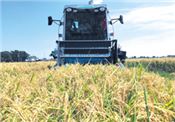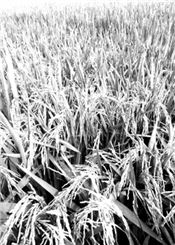|
Rice Growers Anticipate Harvest In September

Mississippi State University field personnel begin the rice harvest on test plots at
the Delta Research and Extension Center in Stoneville, Mississippi.
File photo by MSU Extension Service/Bobby Golden
STONEVILLE, MISS.
Cue the song “Anticipation” for Mississippi’s rice growers because that title and chorus perfectly describe this point in the season.
“The majority of our rice fields are drained, and we are just waiting for conditions to stay dry long enough for harvests,” said Bobby Golden, Extension rice specialist based at the Mississippi State University Delta Research and Extension Center in Stoneville. “The weather has made us about 10 days later than normal. Harvest activity should increase rapidly in the first days of September as long as we stay dry.”
Mississippi has about 200,000 acres of rice, up 33 percent or 50,000 acres from last year. The state’s 2015 rice crop yielded an average of 7,110 pounds per acre for a total value of $132 million.
Golden said 2016 was less complicated than last year, at least until the last weeks approaching rice maturity. Still, Golden said he hopes yields will be better than average.
“Conditions were better than in 2015 from planting until late July and August, when rains started complicating things,” he said. “Rice had perfect disease weather in recent weeks with some pretty severe sheath blight in certain areas.”
Tom Allen, Extension plant pathologist, said sheath blight has been the biggest challenge, but it has not been the only one. Bacterial panicle blight is rare in Mississippi rice production systems, but conditions this year caused some isolated cases of the disease.
“The specific environment for development of bacterial panicle blight is generally considered to be hot, humid weather, especially when temperatures are high during the night,” Allen said. “Nighttime temperatures in the high 70s to low 80s during grain-filling periods can increase the risk associated with bacterial panicle blight.”
Allen said management practices do not reduce the presence of bacterial panicle blight, even after the disease has been detected.
“Fungicides are not active on the bacterial organism,” he said. “As in the past, the fields affected appear to have been planted within a narrow window and were at susceptible or conducive growth stages during the hot, dry weather required for disease development.”
Brian Williams, agricultural economist with the MSU Extension Service, said September rice futures are running around $9.19 per hundredweight. A year ago, rice futures were trading for $11.30 per hundredweight.
“Markets have been on a downward trend since mid-June, with the exception of a brief weeklong run-up in mid-August,” he said. “The biggest driver of rice’s downward trend is forecasts of a record national harvest this fall.”
The U.S. Department of Agriculture is predicting that an estimated 307.7 million hundredweight of rice will be harvested this year in the U.S., which would be the largest crop on record. Ending stocks are also projected to be the highest since 1986.
“The run-up in prices that we saw a couple of weeks ago was in response to the flooding in Louisiana and Arkansas that was preventing much of the crop from being harvested,” Williams said. “The dryer weather pattern that has now moved in is allowing producers to get back into the field in some areas, which has driven the markets back down again.” ∆

Panicle blight has been more common than normal in Mississippi rice fields
in 2016. The upright, infected panicles stand out in this Washington County field.
Submitted photo/James Bowen
|
|